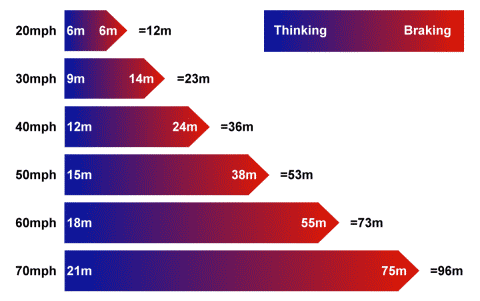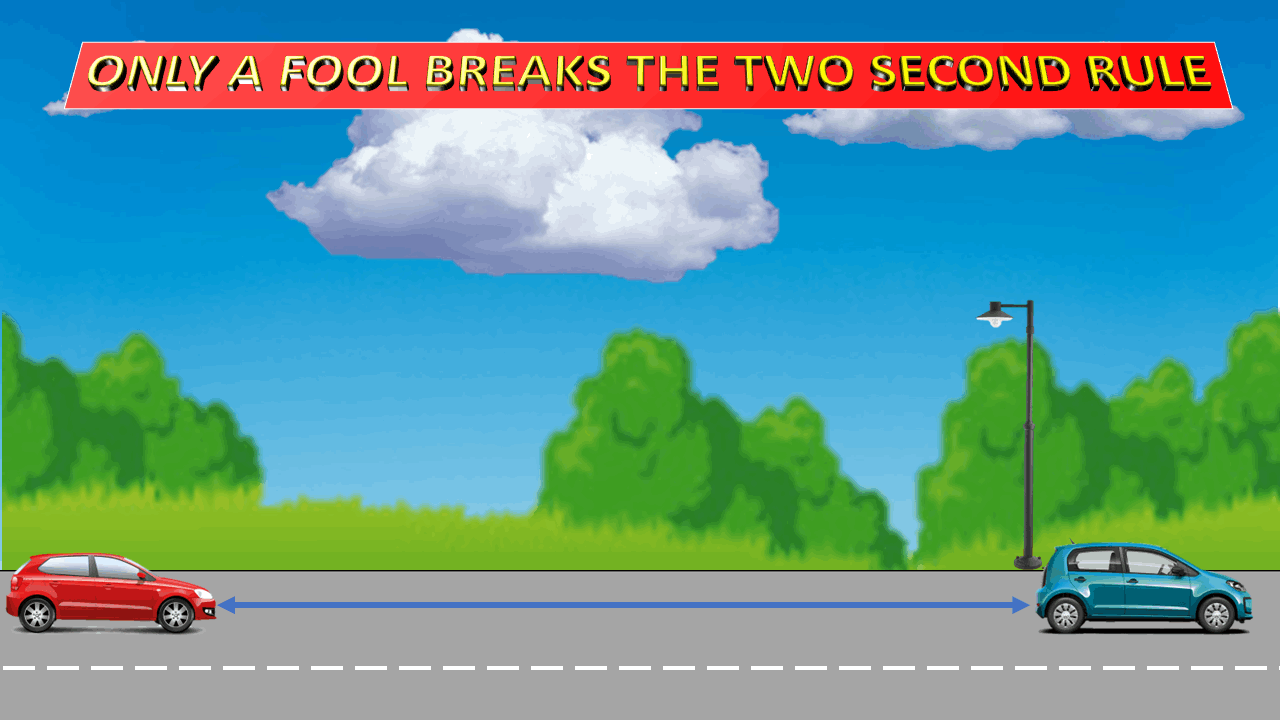

Something we hope never to have to do but,
knowing how to do it will prepare us just in case.
Ultimately Emergency Stopping is a case of bringing the car to a stop in the shortest time possible but with complete control of the vehicle.
As mentioned in previous notes, if you plan ahead, drive within the speed limits, don't get distracted, don't drive in an unfit state, have a roadworthy vehicle, and keep full attention to the task in hand (which should be driving) then the risk of having to carry out an Emergency Stop reduces dramatically.
The routine for an Emergency Stop.
1. Press the brake pedal firmly and as quickly as possible whilst keeping a firm grip with both hands of the steering wheel.
2. Just before the car feels like it is going to stall press the clutch pedal to the floor. This will allow additional slowing as you will be getting engine braking as well as wheel braking.
3. Once the car has come to a complete stop, engage the handbrake.
4. Select neutral on the gear lever.
5. Check your rear view mirror, and brace yourself just in case someone behind cannot stop quickly enough to avoid hitting you.
Emergency braking is the only time when we would understand that a MSPSGL routine is not carried out.
It's an Emergency by all accounts and the last thing on your mind in the first instance is who's behind you.
An emergency may be a child running out into the road, or a vehicle that may have pulled out in front of you,as well as many other things and you do not want to be involved in a road traffic collision.
It may mean that a vehicle following you may not stop in time, but that will possibly be because they are travelling too close to you to allow them enough time to stop.
That being said, it is likely that injuries incurred from a vehicle hitting you from behind will be far less severe than you hitting something that has pulled out in front of you or even worse you hitting a pedestrian.
we teach you to engage the handbrake and select neutral as soon after you stop for two reasons.
1. If a following vehicle were to plough into you from behind and you had not engaged the handbrake or selected neutral you could find that the impact of the following car will make your feet come off all the pedals as you will be thrown backwards into your seat and your legs will raise.
You could be knocked unconscious, and an unconscious driver who has left the car in gear and no handbrake applied is a car in a very dangerous state.
Possibly, if you were knocked unconscious and the car was in gear with no handbrake applied, the car may just jump forward and stall.
It may not stall, and the inertia of the following car hitting you could be enough for your car to not stall and actually continue on along the road. The same road that you have just had to carry out an emergency stop on. For whatever reason, your emergency stop could have avoided the collision, but now you are unconscious and the car is driving along ON ITS OWN! Where could it end up?
Potentially still running over the child that ran out in front of you that you had managed to avoid?
If the car is secure and in neutral the chance of this happening greatly reduces.
We leave checking the rear view mirror until last mainly because it is the least of your worries at the time, but it is checked more than anything to see whether you need to take action to brace yourself for a rear impact.
Once the situation has cleared and hopefully been avoided, you can continue on with your journey, but as with moving off at any time, a full 360 observational check needs to be carried out, and signal if necessary, then move off.
The reason that we try and ensure that the vehicle does not stall, is that had you avoided the collision, checked your rear view mirror and needed to move off quickly to avoid a rear end shunt, you can do so without the extra time needed to re-start your engine first.
Keeping a 2 second gap between you and the vehicle in front of you should allow a safe enough distance for you to be able to come to a stop in an emergency situation on dry roads.
Increase this distance to 4 seconds on a wet road
and 20 seconds on snow and icy roads.

Is the combined thinking and braking distance. If you are paying attention and not driving distracted then these are the average distance required to bring a car to a complete stop.
It's why a SAFE FOLLOWING DISTANCE is so important AT ALL TIMES.
